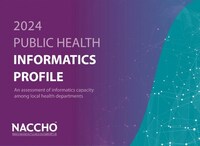News provided by
NACCHO (National Association of County & City Health Officials)Aug 19, 2024, 09:00 ET
2024 Public Health Informatics Profile Highlights Need for Increased Investments to Expand Informatics Services to Improve Health
WASHINGTON, Aug. 19, 2024 /PRNewswire/ -- The National Association of County and City Health Officials (NACCHO), the voice of the over 3,300 local health departments across the country, released its 2024 Public Health Informatics Profile. This is a first-of-its-kind assessment that presents the newest data on local health department informatics capacity, activities for local public health information systems, and opportunities to strengthen local informatics capacity nationwide. The report highlights current informatics activities for local public health and identifies challenges and opportunities to strengthen local informatics capacity.
NACCHO found that most local health departments were working on data modernization projects as of early 2024, despite only a quarter reporting receipt of supplemental funding dedicated to this work. In addition, although use of artificial intelligence (AI) or machine learning was not common, nearly 40% of those local health departments not currently using AI were somewhat or very interested in supplementing their efforts with AI in the future.
The assessment included a nationally representative random sample of 1,200 local health departments.
Other notable findings include:
Informatics Workforce Capacity – While local health departments had internal staff that could perform informatics activities, it was not necessarily their primary dedicated job function. Local health departments reported having epidemiologists (33%) or IT staff (29%) perform informatics and data analysis work. However, staff outside of the local health department—most frequently, within the state health department—bolstered capacity by performing software-based activities.
- Internal staff informatics activities most frequently consist of extracting data from information systems (64%), using and interpreting quantitative data (64%), and maintaining a website (62%).
- More than 60% of local health departments did not have any staff dedicated to informatics services. Workforce-related challenges to data systems were common, with approximately 40% of local health departments citing staff time, workload, and lack of training as very or extremely challenging.
- Sixty-nine percent of local health departments indicated that staff needed skill development in using and interpreting qualitative or quantitative data.
Artificial Intelligence (AI) – Most local health departments were not using AI or machine learning, but 39% of these local health departments were somewhat or very interested in doing so.
- Large local health departments (24%) were more likely to currently be using AI or have plans to use AI in the next year, compared to small (5%) and medium (7%) local health departments.
- Among the 5% of local health departments currently using AI, the most common use was for generating communication materials or plans.
- Seventy-eight percent of local health departments perceived threats related to using AI, with the most common concerns being the reliability of AI and the potential threat to data security.
Informatics Infrastructure and Use – Nearly all local health departments (98%) reported having reliable internet access, which allows for the widespread use of informatics for clinical care, internal services, and programmatic uses, as well as the implementation of information technology systems. Local health departments reported their top program areas for informatics use include infectious disease (68%), environmental health (54%), and preparedness work (50%).
- Sixty-six percent of local health departments cited a lack of funding for informatics as a major challenge for their data systems, and a similar number cited challenges with establishing data exchanges with local, state, or federal entities.
- Over 85% of local health departments were either currently or in the process of implementing immunization registries and electronic disease reporting systems in 2024.
- Most local health departments collaborated with regional or state health departments to monitor and respond to potential outbreaks, and the majority did report having some level of system interoperability with these agencies.
About the 2024 Informatics Assessment
For the 2024 survey, a total of 2,507 local health departments were included in the study population. Rhode Island was excluded from the study because the state health agency operates on behalf of local public health and has no sub-state units. A nationally representative random sample of 1,200 local health departments were invited to complete the survey. NACCHO administered the survey from January to February 2024 with a response rate of 43%.
About NACCHO
The National Association of County and City Health Officials (NACCHO) represents the over 3,300 local governmental health departments across the country. These city, county, metropolitan, district, and tribal departments work every day to protect and promote health and well-being for all people in their communities. For more information, visit www.naccho.org.
SOURCE NACCHO (National Association of County & City Health Officials)
WANT YOUR COMPANY'S NEWS FEATURED ON PRNEWSWIRE.COM?
Newsrooms &
Influencers
Digital Media
Outlets
Journalists
Opted In






Share this article